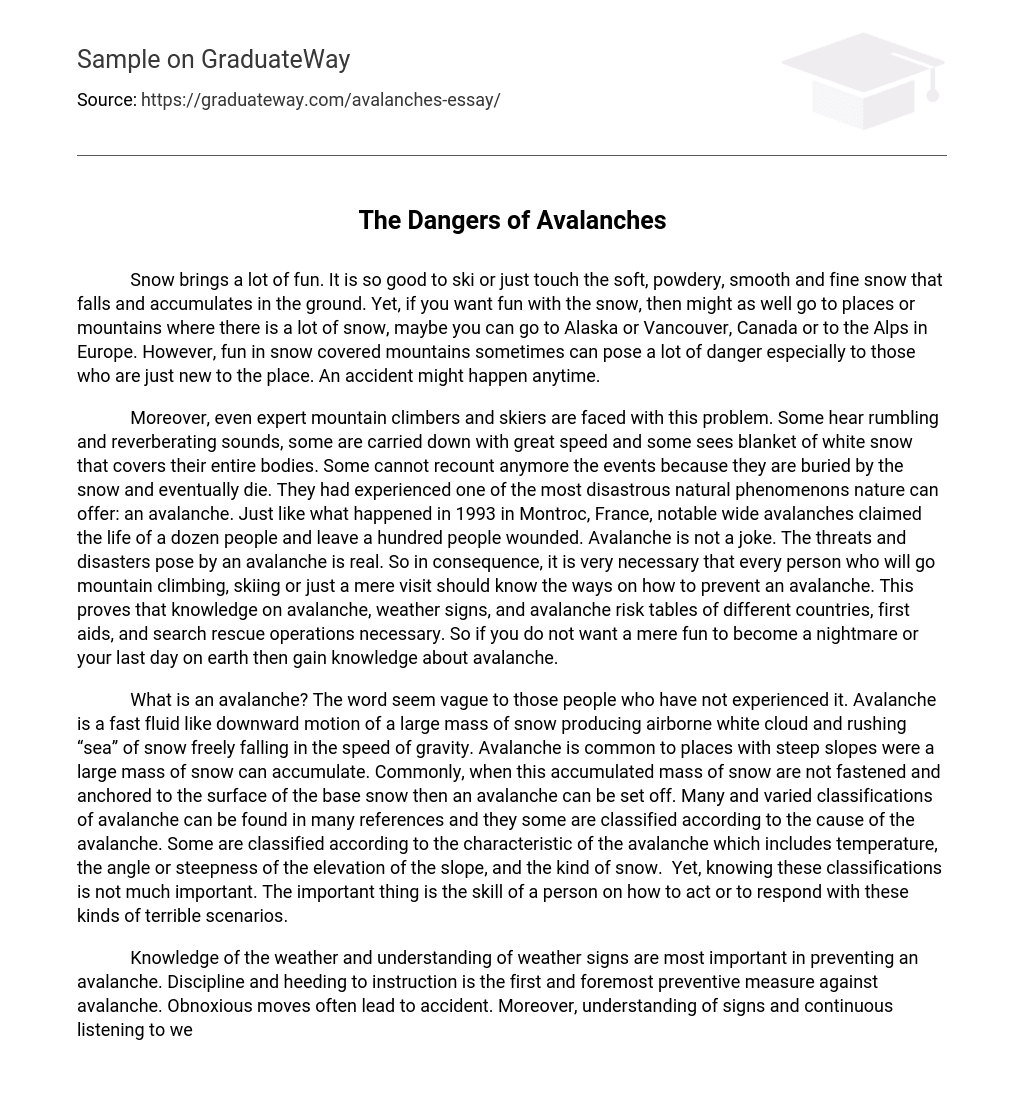Snow brings a lot of fun. It is so good to ski or just touch the soft, powdery, smooth and fine snow that falls and accumulates in the ground. Yet, if you want fun with the snow, then might as well go to places or mountains where there is a lot of snow, maybe you can go to Alaska or Vancouver, Canada or to the Alps in Europe. However, fun in snow covered mountains sometimes can pose a lot of danger especially to those who are just new to the place. An accident might happen anytime.
Moreover, even expert mountain climbers and skiers are faced with this problem. Some hear rumbling and reverberating sounds, some are carried down with great speed and some sees blanket of white snow that covers their entire bodies. Some cannot recount anymore the events because they are buried by the snow and eventually die. They had experienced one of the most disastrous natural phenomenons nature can offer: an avalanche. Just like what happened in 1993 in Montroc, France, notable wide avalanches claimed the life of a dozen people and leave a hundred people wounded. Avalanche is not a joke. The threats and disasters pose by an avalanche is real. So in consequence, it is very necessary that every person who will go mountain climbing, skiing or just a mere visit should know the ways on how to prevent an avalanche. This proves that knowledge on avalanche, weather signs, and avalanche risk tables of different countries, first aids, and search rescue operations necessary. So if you do not want a mere fun to become a nightmare or your last day on earth then gain knowledge about avalanche.
What is an avalanche? The word seem vague to those people who have not experienced it. Avalanche is a fast fluid like downward motion of a large mass of snow producing airborne white cloud and rushing “sea” of snow freely falling in the speed of gravity. Avalanche is common to places with steep slopes were a large mass of snow can accumulate. Commonly, when this accumulated mass of snow are not fastened and anchored to the surface of the base snow then an avalanche can be set off. Many and varied classifications of avalanche can be found in many references and they some are classified according to the cause of the avalanche. Some are classified according to the characteristic of the avalanche which includes temperature, the angle or steepness of the elevation of the slope, and the kind of snow. Yet, knowing these classifications is not much important. The important thing is the skill of a person on how to act or to respond with these kinds of terrible scenarios.
Knowledge of the weather and understanding of weather signs are most important in preventing an avalanche. Discipline and heeding to instruction is the first and foremost preventive measure against avalanche. Obnoxious moves often lead to accident. Moreover, understanding of signs and continuous listening to weather reports is very significant. Awareness and sensitivity to mountain signs and danger advisories is also important. Ski resorts staffs are also responsible in informing their skiers about the temperature, the direction of the wind, the snow pack and other indicators to ensure safety skiing.
However, still, an avalanche is an accident. Sometimes, meaningful preventions and avoidances are still not enough. There are people who do not seek their annihilation and devastation yet they just prawn to it. Some of these people live on the hillside or at the footsteps of the mountain. Therefore, it is vital that people should still have the basic knowledge on how to survive in case of an avalanche. However, knowledge and understanding is not enough. In dealing with avalanche, people should have materials and equipments that could save their lives.
For example, one of the most important things is a medium of communication were people can know updates of the weather. In addition to this are materials like torches or flashlights for light source, first aid kits, shovels, cellular phones, GPS devices and other. Hitherto, a possession of these materials and equipments is not a sure ticket that one can survive the risk of avalanche. However possession of these equipments and proper use of the\m increases the chance of a victim’s survivability. Once an avalanche occurs, it cannot be stopped until on itself, it stops. Many avalanche survivors stated their story and most of them agreed that the will power of their self, the spirit and the desire to survive keep them alive.
Moreover, it is also the accountability of the state to secure the safety of its citizen. At the aftermath of an occurrence of an avalanche and many people were affected by the disaster, it is the job and responsibility of the federal authorities to conduct speedily and quickly a search and rescue operation if it will not endanger the life of their rescuers. A quick response of the authorities is considered indispensable because victims buried in the snow have low possibility of survival because may get asphyxiated or suffer hypothermia. Yet, societies and governments of the world seem responsive and alert with regards to the safety of their citizens. They had their own risk tables or danger scales about avalanche and they had their own disaster management and contingency plan.
However, even prevented, accidents can occur anywhere and at anytime, even at home or at school. Meaningful and dependable deterrence and preclusion is required to avoid accidents. Enough Information, knowledge, materials and skill can prolong or increase a person’s survivability.
Works Cited
Hackett, S.W, and D. Fesler. “Informal Cooperative State-federal Avalanche Warning System and Public Education Program for South Central Alaska, USA. Journal of Glaciology 26(1980): 377-392.
Lackinger, B.. “Supporting Forces and Stability of Snow Slab Avalanches.” International Association of Hydrological Scences Publications. 162(1989):229-241.
Moskalev, Y.D..” On the Mechanism of the Formation of Wet Snow Avalanches”. International Association of Hydrological Scences Publications. 69(1966):196-198.





